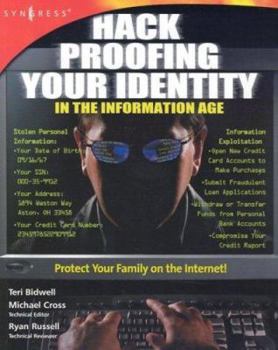Hack Proofing Your Identity in the Information Age
Identity-theft is the fastest growing crime in America, affecting approximately 900,000 new victims each year. Protect your assets and personal information online with this comprehensive guide. Hack... This description may be from another edition of this product.
Format:Paperback
Language:English
ISBN:1931836515
ISBN13:9781931836517
Release Date:August 2002
Publisher:Syngress Publishing
Length:512 Pages
Weight:1.55 lbs.
Dimensions:0.9" x 7.5" x 9.3"
Customer Reviews
2 ratings
Good information for the average computer user...
Published by Thriftbooks.com User , 20 years ago
Target AudienceAnyone who is an internet user and hasn't thought about protecting their identity.ContentsThis book outlines the issues involved in protecting your identity in an online environment, along with giving practical suggestions on how to do so.The book is divided into the following chapters: Identity Theft: Are You At Risk?; Protecting Your Hard Drive; Keeping Your Email Private; Self-Defense On The Web; Connecting To The Internet Safely; Are Your Kids Putting You At Risk?; If You Become A Victim; Configuring Your Browser And Firewall; IndexReviewIf you're a long-time techno-geek, you've no doubt been aware of the risks of exposing your identity on the Internet. You make sure credit cards are only used over encrypted links, you don't fall for phishing scams, and so on. But as more people have started to go online over the years, the incidents of computer crime and identity theft have risen dramatically. To combat your exposure to those scams, you should read Hack Proofing Your Identity In The Information Age.The typical computer user will pick up quite a bit from this book. The first chapter will introduce the concept of identity theft and how easy it is for someone to glean information from you and use it to open credit accounts. There is also information here on how to avoid theft by non-electronic methods, such as securing your mail and cell phone. Subsequent chapters go more into detail on specific areas, such as email and web browsing. While the authors rightly state that it is impossible to completely protect yourself against a determined attacker, reading and implementing the material that you find in this book will significantly decrease your chances of becoming a victim.To the techno-geek who's been living in the computer age for a long time, you will undoubtedly know most of this information. Even so, it's not assured that you will never become a victim. The chapter titled If You Become A Victim is a good reference on what steps to take once you determine that you've been targeted. Since it can be a stressful experience to clean up the damage, the convenience of having all the steps spelled out for you can be a lifesaver.ConclusionA good book for people who have never considered the risks of identity theft as they surf the internet, as well as for someone who is trying to clean up the damage once the theft occurs.
Read and Apply This Information
Published by Thriftbooks.com User , 21 years ago
The developed world is in a transition. We are becoming an information economy. A result of this is that our identity is more important than ever and our identities are at risk of being stolen and misused! Hack Proofing Your Identity covers the fundamentals you need to know about identity theft. The book is primarily positioned as an awareness tool and is a serious wake up call. The author, Teri Bidwell clearly makes the point that simple everyday tasks such as writing checks, using credit cards, logging onto the Internet to perform on-line banking or stock trading reveal our private information to the outside world.This book is directed towards real people, the average computer user, and avoids the gargon you might see in a text written for IT workers. Parents will also find this book intriguing as it teaches cyber security for children. The Author not only shares ways of protecting yourself and your private information, but also provide an in-depth introduction and summary of each chapter, as well as fast track solutions and frequently asked questions.The book begins with identity theft and outlines what electronic information is truly private and how your personal information can be used against you. Then it moves on to a discussion about choosing strong passwords, installing and updating antivirus software as well as file encryption.There is a fascinating discussion about how to protect your identity while using E-mail and the Internet. The book makes it clear that connecting to the Internet connects you to the rest of the world! Raising children in the cyber and digital age brings a whole new set of challenges. Parents need to educate children about computerized sexual predators, unethical and illegal uses of computers. This is not a pleasant topic, but it is crucial. My own son nearly fell prey to one as a young teenager. My wife found him in the garage on the phone with an older lady who was trying to set up a rendezvous. They had met in a chat room. The book shows you how to protect children from becoming victims of crime on the Internet. What happens if you become a victim of identity theft? How do you protect yourself or regain your identity? This is covered as well. The bottom line, this is an approachable book that covers the basic information that you really should think about. Read it then make sure your spouse, your parents and your kids know this stuff and put it into practice.





